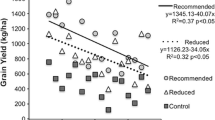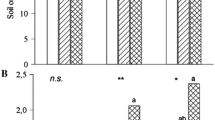Abstract
The decline of cooking banana production in parts of East Africa hasbeen associated with a loss of soil fertility and increased pest pressure.Previous work indicated that the use of mineral fertilizers at recommendedratesis not financially viable on plantations where pest pressure is high. Theobjectives of this study were to determine the effects of half the recommendedrates of mineral fertilizers and organic mulch on banana yield, soil and foliarnutrient status, soil water and pest damage in the central region of Uganda.Thestudy was conducted in a four-year old banana plantation infested with weevils.Treatments consisted of mineral fertilizer alone, mulch alone, a combination ofmulch with fertilizer, and a control (no mulch from outside the plot, ormineralfertilizer applied). Fruit yield was generally low (mean of 7.4 Mgha−1 yr−1) and increases above thecontrol ranged from 1.1 to 2.0 Mg ha−1 yr−1. Banana yield was significantly higher in the solemulch treatment than in the control. However, there were no significantdifferences in yield among the treatments that received external inputs. Thus,there was no demonstrable yield advantage of combining mineral fertilizer withmulch. At the end of the trial, soil K concentrations in the two treatmentsthatwere mulched, were almost twice those of the control, but this difference wasnotstatistically significant. Concentrations of Ca and Mg did not differ withtreatment. Soil available P significantly increased when mineral fertilizer andorganic mulch were combined. Treatments that received organic mulch were lowerin foliar concentrations of N and Mg, and higher in K. Soil water content wasgreater in the surface soil layer in the treatments that received mulch,presumably due to less surface run-off and evaporation, since there was nochangein surface soil porosity. The effect of organic and inorganic amendments had noimpact on weevil damage, which remained above 5% at the end of the trial. Weconclude that where weevil damage is over 5% of the cross section near thecollar, banana production may not be economically increased through use ofeither mineral fertilizer and/or organic mulch.
Similar content being viewed by others
References
Adupa R. and Ngambeki D.S. 1994. Demand and consumption of bananas in Uganda. Afric. Crop Sci. Conf. Proc. 1: 379–383.
Angeles D.E., Sumner M.E. and Lahav E. 1993. Preliminary DRIS norms for banana. J. Plant Nutr. 16: 1059–1070.
Boscan de Martinez N. and Godoy F. 1989. Epocas de incidencia de Cosmopolites sordidus G. y de Metamasius hemipterus L. en dos huertos de musaceas en el estado de Aragua. Agronomia Tropical 38: 107–119.
Delvaux B. 1995. Soils. In: Gowen S. (ed.), Bananas and Plantains. Chapman & Hall, London, pp. 230–257.
Gold C.S., Speijer P.R., Karamura E.B., Tushemereirwe W.K. and Kashaija I.N. 1994. Survey methodologies for pest and disease assessment in Uganda. Afric. Crop Sci. J. 2: 309–321.
Gold C.S., Karamura E.B., Kiggundu A., Bagamba F. and Abera A.M.K. 1999. Geographic shifts in the highland cooking banana (Musa spp group AAA-EA) production in Uganda. Int. J. Sustain. Dev. World Ecol. 6: 45–59.
Gordon J. and Ordish G. 1966. Insect pests of banana. In: PANS Manual No. 1, Bananas, pp. 33–35.
Hillel D. 1998. Environmental Soil Physics. Academic Press, San Diego, CA, p. 389.
Hooper D.J. 1990. Extraction and processing of plant and soil nematodes. In: Luc M., Sikora R.A. and Bridge J. (eds), Plant Parasitic Nematodes in Subtropical and Tropical Agriculture. CAB International, Wallingford, UK, pp. 45–68.
Jones M.T. 1986. Pests and diseases of bananas and plantains of Trinidad and Tobago. J. Agric. Soc. Trin. Tob. 86: 18–33.
Kiggundu A. 2000. Host plant reactions and resistance mechanisms to banana weevil, Cosmopolites sordidus (Germar) in Ugandan Musa germplasm, M.Sc. Thesis, Orange Free State University, South Africa.
Mbwana A.S.S. and Rukazambuga N.D.T.M. 1999. Banana IPM in Tanzania. In: Frison E.A., Gold C.S., Karamura E.B. and Sikora R.A. (eds), Mobilizing IPM for Sustainable Production in Africa: Proceedings of a Workshop Held in Nelspruit, South Africa, 23–28 November 1998. INIBAP, Montpellier, France, pp. 237–245.
McIntyre B.D., Speijer P.R., Riha S.J. and Kizito F. 2000. Effects of mulching on biomass, nutrients, and soil water in banana inoculated with nematodes. Agron. J. 92: 1081–1085.
Mesquita A.L.M., Alves E.J. and Caldas R.C. 1984. Resistance of banana cultivars to Cosmopolites sordidus (Germar 1824). Fruits 39: 254–257.
Montellano B. 1954. Estudios biologicos del Cosmopolites sordidus Germar que infesta al rizoma de abaca. Tesis Mag. Agr. Turrialba, Costa Rica. IICA 27 pp.
Myers R.J.K., Palm C.A., Cuevas E., Gunatilleke I.U.N. and Brossard M. 1994. The synchronisation of nutrient mineralisation and plant nutrient demand. In: Woomer P.L. and Swift M.J. (eds), The Biological Management of Tropical Soil Fertility. TSBF/John Wiley, West Sussex, UK, pp. 81–116.
Parkinson J.A. and Allen S.E. 1975. A wet oxidation procedure suitable for the determination of nitrogen and mineral nutrients in biological material. Commun. Soil Sci. Plant Anal. 6: 1–11.
Price N.S. 1994. Alternate cropping in the management of Radopholus similis amd Cosmopolites sordidus, two important pests of banana and plantain. Int. J. Pest Manage. 40: 237–244.
Rukazambuga N.D.T.M. 1996. The effects of banana weevil (Cosmopolites sordidus Germar) on the growth and productivity of bananas (Musa AAA-EA) and the influence of host vigour on attack, Ph.D. Thesis, University of Reading, Reading, UK.
Rukazambuga N.D.T.M., Gold C.S. and Gowen S.R. 1998. Yield loss in East African Highland Banana (Musa spp, AAA-EA group) caused by the banana weevil, Cosmopolites sordidus Germar. Crop Protection 17: 1–9.
Sebasigari K. and Stover R.H. 1988. Banana Diseases and Pests in East Africa: Report of a Survey in November 1987. INIBAP, Montpellier, France.
Sikora R.A., Bafokuzara N.D., Mbwana A.S.S., Oloo G.W., Uronu B. and Seshu Reddy K.V. 1989. Interrelationships between banana weevil, root lesion nematodes and agronomic practices and their importance for banana decline in Tanzania. FAO Plant Protect. Bull. 37: 151–157.
Smithson P.C., McIntyre B.D., Gold C.S., Ssali H. and Kashaija I.N. 2001. Nitrogen and potassium fertilizer vs. nematode and weevil effects on yield and foliar nutrient status of banana in Uganda. Nutrient Cycl. Agroecosys. 59: 239–250.
Snedecor G.W. and Cochrane W.G. 1991. Statistical Methods. 8th edn. Iowa State University Press, Ames, Iowa, USA.
Speijer P.R., Gold C.S., Kashaija I.N. and Karamura E.B. 1994. Assessment of nematode damage in East African highland banana systems. In: Valmayor R.V., Davide R.G., Stanton J.M., Treverrow N.L. and Roa V.N. (eds), Banana Nematodes and Weevil Borers in Asia and the Pacific: Proceedings of a Conference-workshop in Serdang, Malaysia, 18–22 April 1994. Inibap/Aspnet Los Banos, Phillipines.
Sponagel K.W., Diaz F.J. and Cribas A. 1995. El picudo negro del platano, Cosmopolites sordidus Germar. FHIA, La Lima, Honduras.
Ssenyonga J.W., Bagamba F., Gold C.G., Tushemereirwe W.K., Ssendege R. and Katungi E. 1998. Understanding current banana production with special reference to integrated pest management in southwestern Uganda. Research report of the socioeconomic component of the banana-based cropping systems project to the Rockefeller Foundation.
Sumner M.E. 1979. Interpretation of foliar analyses for diagnostic purposes. Agron. J. 71: 343–348.
Treverrow N. 1993. An integrated management program for banana weevil borer. Final report, HRDC Project No Fr/0012/RO. Wollongbar Agricultural Institute, Wollongbar, NSW, Australia.
Vilardebo A. 1984. Problemes scientifiques poses par Radopholus similis et Cosmopolites sordidus en cultures bananieres des zones francophones de production. Fruits 39: 227–233.
Walmsley D., Twyford I.T. and Cornforth I.S. 1971. An evaluation of soil analysis methods for nitrogen, phosphorus and potassium, using banana. Trop. Agric. (Trinidad) 48: 141–155.
Wortmann C.S., Bosch C.H. and Mukandala L. 1994. Foliar nutrient analyses in banana grown in the highlands of East Africa. J. Agron. Crop Sci. 172: 223–226.
Yost D. and Eswaran H. 1990. Major Land Resource Areas of Uganda. World Soil Resources/SMSS/USAID, Washington, DC, USA.
Author information
Authors and Affiliations
Rights and permissions
About this article
Cite this article
Ssali, H., McIntyre, B., Gold, C. et al. Effects of mulch and mineral fertilizer on crop, weevil and soil quality parameters in highland banana. Nutrient Cycling in Agroecosystems 65, 141–150 (2003). https://doi.org/10.1023/A:1022184927506
Issue Date:
DOI: https://doi.org/10.1023/A:1022184927506




